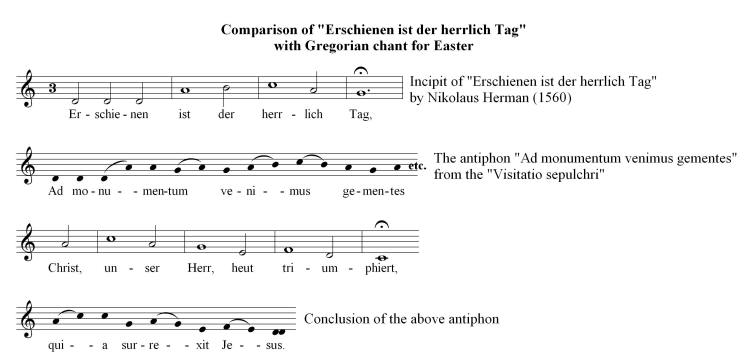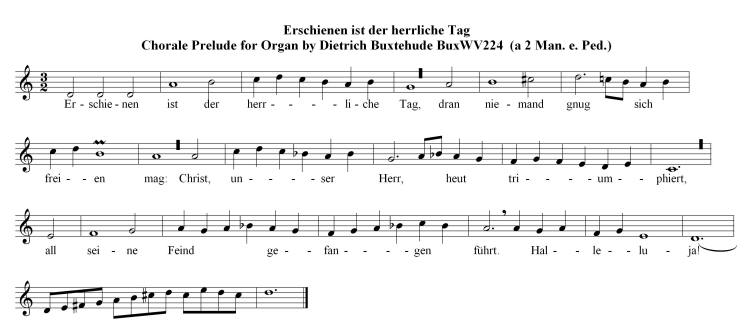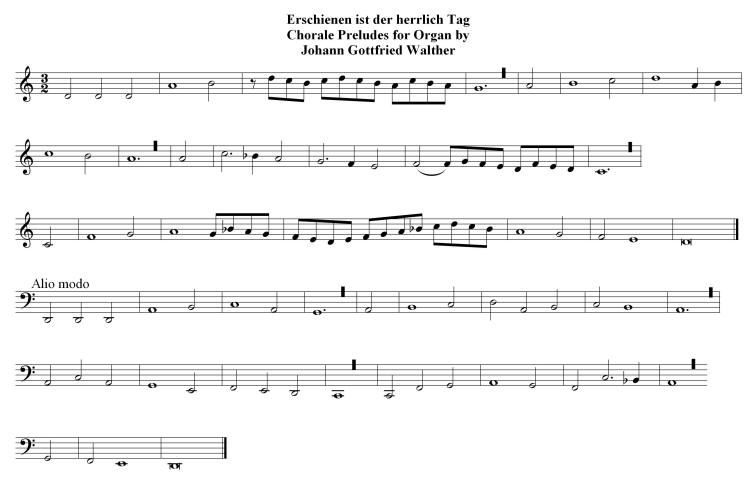|
Chorale Melodies used in Bach's Vocal Works
Erschienen ist der herrlich Tag
|
|
Melody & Text | Use of the CM by Bach | Use of the CM by other composers |
| |
|
Melody & Text: Zahn: 1743 | EKG: 80 |
|
EKG: has only 5 verses with melody and text by Nikolaus Herman (c. 1480-1561) - The original had 14 verses! |
| |
|
Text: |
|
Nikolaus Herman, born in Altdorf near Nürnberg, a cantor at St. Joachimsthal in Bohemia. A poet (text writer) and composer of numerous chorales still in the present-day EKG including:
Lobt Gott, ihr Christen alle gleich (1554)*
Wir wollen singn ein’ Lobgesang
Heut singt die liebe Christenheit (1560)
Erschienen ist der herrlich Tag (1560) (in a few later hymnals ‚herrlich’ is sometimes spelled ‚herrliche’)*
Ein wahrer Glaube Gotts Zorn stillt
Wenn mein Stündlein vorhanden ist*
Die helle Sonn leucht’ jetzt herfür
Hinunter ist der Sonnen Schein
Bescher uns, Herr, das täglich Brot
* Chorale melodies with settings by Bach. |
| |
|
Melody: |
|
With a similar technique sometimes used by Luther and others in the 16th century, Nikolaus Herman’s chorale melody has allusions to Pre-Reformation liturgical chants, but also has much original material, perhaps some of this based on folksongs, in it as well. It is not a simple adaptation of Latin text liturgy with a new German text as frequently occurs, but rather a complete transformation of the melodic material with only certain phrases reminiscent of a possible original connection with the Gregorian chant for Easter. Specifically, the Easter antiphon “Ad monumentum venimus” from the “Visitatio sepulchri” has some possible connections to Herman’s chorale melody. The chorale melody first appeared in the “Sontags Euangelia”, Wittenberg, 1560. For a comparison of the Gregorian chant with Herman’s melody see: |
|

|
| |
|
Hymnal versions Bach may have known: |
|
from a 17th century hymnal |
|

|
|
Gotha, 1715 |
|

|
| |
|
The Chorale in the Post-Reformation Period (Background for this chorale) |
|
Luther’s death was followed by a period of consolidation against the challenge of the Counter-Reformation; this was furthered by rationalizing the liturgical organization of the Reformation chorale repertory. In Johann Eichorn’s regional hymnbook (Frankfurt an der Oder, 1559) the central repertory of Lutheran chorales was arranged according to the utilitarian categories of the Bohemian Brethren, instead of being arranged by author according to the early Lutheran system - a procedure which gave those of Luther great prominence and permanence and kept the others from becoming firmly established in the repertory. An orthodox tradition was further codified by a complete de tempore ordering of chorales for the church year in Johannes Keuchenthal’s Kirchen Gesenge latinisch und deudsch (Wittenberg, 1573) and Nikolaus Selnecker’s Christliche Psalmen, Lieder und Kirchengesänge (Leipzig, 1587).
The conservative tendencies of the period, combined with war, plague and famine in the second half of the 16th century, resulted in a reduction in the number of new chorales and in a shift in emphasis to themes of the Crucifixion and comfort, death and eternal life and the Second Coming, while the conflict with the Counter-Reformation generated chorale texts concerning pure Christian doctrine and the life and work of the church. Accordingly the years from about 1570 to 1648, which include the post-Reformation period and the Thirty Years War, have often been referred to as the age of the ‘Bekenntnis- und Glaubenslied’ (chorales of confession, or creed, and faith).
The most important hymn writer at the beginning of this period was Nicolaus Herman of Joachimsthal in Bohemia, a contemporary of Luther but a transitional figure; his chorales (for which he wrote both the texts and melodies), including Lobt Gott, ihr Christen alle gleich and Erschienen ist der herrlich Tag, were not published until 1560, and then, significantly, in a one-author collection of home devotions and children’s hymns for the church year. His chorales show the continuing influence of the Meistersinger traditions in their quantitative scansion and use of church modes with existing melodies and melodic formulae, but the folklike simplicity of his texts and his increased use of pure major-mode melodies reflect new tendencies. In the work of a younger generation, Nikolaus Selnecker, Paul Eber (1511-1569), Ludwig Helmbold, Bartholomäus Ringwaldt (1530-1599) and Martin Schalling (1532-1600), a more personal tone of Lutheran humanism is discernible, particularly in the texts of Helmbold’s Von Gott will ich nicht lassen and Schalling’s Herzlich lieb hab ich dich, o Herr.
Author: Robert L. Marshall, Robin A. Leaver
From Grove Music Online, Oxford University Press, 2006, acc. 3/1206 |
| |
|
Use of the Chorale Melody by Bach: |
|
Text: Erschienen ist der herrlich Tag |
EKG: 80
Author: Nicolaus Herman (1560) |
|
Ver |
Work |
Mvt. |
Year |
Br |
RE |
KE |
Di |
BC |
Score |
Music Examples |
|
1 |
BWV 67 |
Mvt. 4 |
1724 |
- |
83 |
- |
- |
A62:4 |
PDF |
Mvt. 4 (MG) [midi] | Mvt. 4 (Leusink) [ram] |
|
14 |
BWV 145 |
Mvt. 5 |
1729 or later |
17
Anh 1 |
84 |
17 |
- |
A60:5 |
PDF | PDF v |
Mvt. 5 (MG) | Mvt. 5 (MG) ver [midi] | Mvt. 5 (Leusink) [ram] |
|

|
|

|
|
Untexted: |
|
Ver |
Work |
Mvt. |
Year |
Br |
RE |
KE |
Di |
BC |
Score |
Music Examples |
|
- |
BWV 629 |
- |
1713/15 |
- |
- |
- |
- |
K59 |
- |
|
|
BWV 629: Orgelbüchlein No. 31 |
|

|
| |
|
Use of the Chorale Melody by other composers: |
|
Johann Hermann Schein (1586-1630):
Erschienen ist der herrlich Tag for SATB + bc (1627) |
|
Samuel Scheidt (1587-1654):
Erschienen ist der herrlich Tag, a 4-pt. setting (Görlitz, 1650) |
|

|
|
Dietrich Buxtehude (c1637-1707):
Erschienen ist der herrlich Tag, Chorale Prelude for Organ, BuxWV 224 |
|

|
|
Johann Gottfried Walther (1684-1748):
Erschienen ist der herrlich Tag, 2 Chorale Preludes for Organ , 2 Chorale Preludes for Organ |
|

|
|
Georg Friedrich Kauffmann (1679-1735):
Chorale Prelude for Organ on Erschienen ist der herrliche Tag (Leipzig, 1733) |
|

|
|
Philipp Spitta (1841-1894) (the great Bach biographer):
Partita Erschienen ist der herrlich Tag for Soprano, Female Voices. and Strings, op. 96, Ms. |
| |
|
Sources: NBA, vols. III/2.1 & 2.2 in particular [Bärenreiter, 1954 to present] and the BWV ("Bach Werke Verzeichnis") [Breitkopf & Härtel, 1998]
The PDF files of the Chorales were contributed by Margaret Greentree J.S. Bach Chorales
Software: Capella 2004 Software, version 5.1.
Prepared by Thomas Braatz & Aryeh Oron (March 2006) |